Tem microscope lens - Study guides, Class notes & Summaries
Looking for the best study guides, study notes and summaries about Tem microscope lens? On this page you'll find 122 study documents about Tem microscope lens.
All 122 results
Sort by
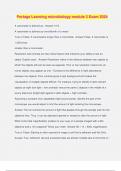 Popular
Popular
-
Portage Learning microbiology module 3 Exam 2024
- Exam (elaborations) • 5 pages • 2024
- Available in package deal
-
- $11.49
- 1x sold
- + learn more
Portage Learning microbiology module 3 Exam 2024 A nanometer is defined as: -Answer-10-9 A nanometer is defined as one-billionth of a meter True or False: A nanometeris longer than a micrometer -Answer-False. A nanometer is 1,000 times smaller than a micrometer. Resolution and contrast are two critical factors that influence your ability to see an object. Explain each. -Answer-Resolution refers to the distance between two objects at which the objects still can be seen as separate. Poor o...
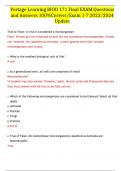
-
BIOD 171 Portage Learning Final EXAM Questions and Answers 100%Correct/Exam 1-7 2023/2024 Update
- Exam (elaborations) • 44 pages • 2023
-
- $20.99
- 5x sold
- + learn more
BIOD 171 Portage Learning Final EXAM Questions and Answers 100%Correct/Exam 1-7 2023/2024 UpdatePortage Learning BIOD 171 Final EXAM Questions and Answers 100%Correct/Exam 1-7 2023/2024 Update True or False: A virus is considered a microorganism. False. Viruses are not living and as such are not considered microorganisms. Viruses can, however, be classified as microbes, a more general term that includes microorganisms and viruses. 1. What is the smallest biological unit of life? A cell. ...
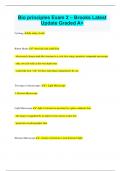
-
Bio principles Exam 2 – Brooks Latest Update Graded A+
- Exam (elaborations) • 63 pages • 2024
- Available in package deal
-
- $11.99
- + learn more
Bio principles Exam 2 – Brooks Latest Update Graded A+ Cytology the study of cells Robert Hooke - observed cork could float - discovered a honeycomb-like structure in a cork slice using a primitive compound microscope - only saw cell walls as this was dead tissue - coined the term "cell" for these individual compartments he saw Two types of microscopes: 1. Light Microscope 2. Electron Microscope Light Microscope - light is focused on specimen by a glass condenser lens -...
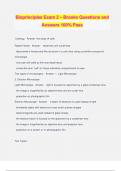
-
Bioprinciples Exam 2 – Brooks Questions and Answers 100% Pass
- Exam (elaborations) • 42 pages • 2024
-
- $13.49
- + learn more
Bioprinciples Exam 2 – Brooks Questions and Answers 100% Pass Cytology - Answer- the study of cells Robert Hooke - Answer- - observed cork could float - discovered a honeycomb-like structure in a cork slice using a primitive compound microscope - only saw cell walls as this was dead tissue - coined the term "cell" for these individual compartments he saw Two types of microscopes: - Answer- 1. Light Microscope 2. Electron Microscope Light Microscope - Answer- - light is focused on s...
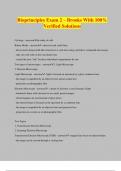
-
Bioprinciples Exam 2 – Brooks With 100% Verified Solutions
- Exam (elaborations) • 31 pages • 2024
- Available in package deal
-
- $13.49
- + learn more
Bioprinciples Exam 2 – Brooks With 100% Verified Solutions Cytology - answerthe study of cells Robert Hooke - answer- observed cork could float - discovered a honeycomb-like structure in a cork slice using a primitive compound microscope - only saw cell walls as this was dead tissue - coined the term "cell" for these individual compartments he saw Two types of microscopes: - answer1. Light Microscope 2. Electron Microscope Light Microscope - answer- light is focused on specimen by a...
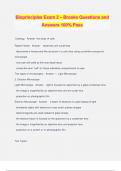
-
Bioprinciples Exam 2 – Brooks Questions and Answers 100% Pass
- Exam (elaborations) • 42 pages • 2024
- Available in package deal
-
- $13.49
- + learn more
Bioprinciples Exam 2 – Brooks Questions and Answers 100% Pass Cytology - Answer- the study of cells Robert Hooke - Answer- - observed cork could float - discovered a honeycomb-like structure in a cork slice using a primitive compound microscope - only saw cell walls as this was dead tissue - coined the term "cell" for these individual compartments he saw Two types of microscopes: - Answer- 1. Light Microscope 2. Electron Microscope Light Microscope - Answer- - light is focused on s...
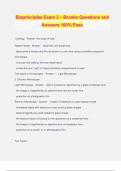
-
Bioprinciples Exam 2 – Brooks Questions and Answers 100% Pass
- Exam (elaborations) • 42 pages • 2024
- Available in package deal
-
- $13.49
- + learn more
Bioprinciples Exam 2 – Brooks Questions and Answers 100% Pass Cytology - Answer- the study of cells Robert Hooke - Answer- - observed cork could float - discovered a honeycomb-like structure in a cork slice using a primitive compound microscope - only saw cell walls as this was dead tissue - coined the term "cell" for these individual compartments he saw Two types of microscopes: - Answer- 1. Light Microscope 2. Electron Microscope Light Microscope - Answer- - light is focused on s...
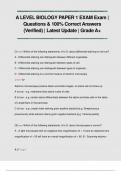
-
A LEVEL BIOLOGY PAPER 1 EXAM Exam | Questions & 100% Correct Answers (Verified) | Latest Update | Grade A+
- Exam (elaborations) • 17 pages • 2024
-
- $13.49
- + learn more
Q1 >>> Which of the following statements, A to D, about differential staining is not true? A - Differential staining can distinguish between different organelles. B - Differential staining can distinguish between types of cell. C - Differential staining can distinguish between types of organism. D - Differential staining is a common feature of electron microscopy : *D* Electron microscopes produce black and white images, so stains will not show up A is true - e.g. methylene ...
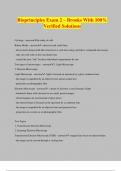
-
Bioprinciples Exam 2 – Brooks With 100% Verified Solutions
- Exam (elaborations) • 31 pages • 2024
- Available in package deal
-
- $13.49
- + learn more
Bioprinciples Exam 2 – Brooks With 100% Verified Solutions Cytology - answerthe study of cells Robert Hooke - answer- observed cork could float - discovered a honeycomb-like structure in a cork slice using a primitive compound microscope - only saw cell walls as this was dead tissue - coined the term "cell" for these individual compartments he saw Two types of microscopes: - answer1. Light Microscope 2. Electron Microscope Light Microscope - answer- light is focused on specimen by a...
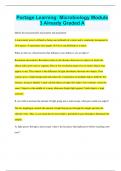
-
Portage Learning: Microbiology Module 3 Already Graded A
- Exam (elaborations) • 18 pages • 2023
- Available in package deal
-
- $9.99
- + learn more
Portage Learning: Microbiology Module 3 Already Graded A Define the measurements micrometer and nanometer. A micrometer (μm) is defined as being one-millionth of a meter and is commonly designated at 10-6 meters. A nanometer (nm) equals 10-9 m or one-billionth of a meter. What are the two critical factors that influence your ability to see an object? Resolution and contrast. Resolution refers to the distance between two objects at which the objects still can be seen as separate. Poor or low r...

$6.50 for your textbook summary multiplied by 100 fellow students... Do the math: that's a lot of money! Don't be a thief of your own wallet and start uploading yours now. Discover all about earning on Stuvia


